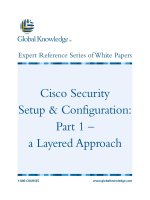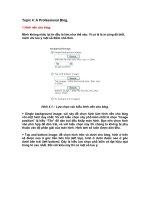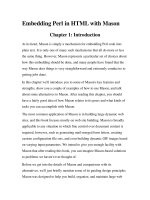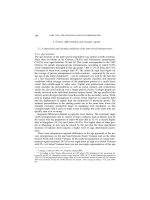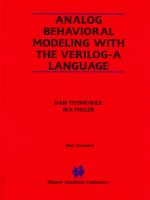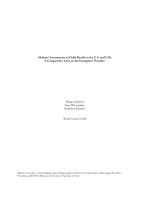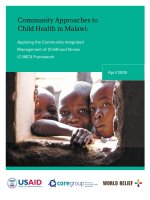Tài liệu Distance learning in academic health education: A literature review pdf
Bạn đang xem bản rút gọn của tài liệu. Xem và tải ngay bản đầy đủ của tài liệu tại đây (131.25 KB, 10 trang )
Eur J Dent Educ 2001; 5: 67–76
Copyright C Munksgaard 2001
Printed in Denmark. All rights reserved
ISSN 1396-5883
Distance learning in academic health education
A literature review
Nikos Mattheos
1
, Martin Schittek
1
, Rolf Attström
1,2
and H. C. Lyon
3
*
1
Department of Periodontology, Centre for Oral Health Sciences, Malmoe University, Malmoe, Sweden;
2
Department of Periodontology and Fixed
Prosthodontics, School of Dental Medicine, University of Berne, Berne, Switzerland;
3
Notre Dame College, Manchester, NH USA
Distance learning is an apparent alternative to traditional
methods in education of health care professionals. Non-interac-
tive distance learning, interactive courses and virtual learning en-
vironments exist as three different generations in distance learn-
ing, each with unique methodologies, strengths and potential.
Different methodologies have been recommended for distance
learning, varying from a didactic approach to a problem-based
learning procedure. Accreditation, teamwork and personal con-
tact between the tutors and the students during a course pro-
vided by distance learning are recommended as motivating fac-
tors in order to enhance the effectiveness of the learning. Numer-
ous assessment methods for distance learning courses have
been proposed. However, few studies report adequate tests for
the effectiveness of the distance-learning environment. Available
information indicates that distance learning may significantly de-
crease the cost of academic health education at all levels. Fur-
thermore, such courses can provide education to students and
D
ISTANCE LEARNING
(DL) is not a new phenom-
enon. Correspondence courses are reported to
have existed in England as early as the 1840s. The
University of Chicago established a correspondence
division in the 1890s (1). Applications of distance
learning have closely reflected the evolution of com-
munications technology (2). The explosive progress of
communications experienced during the last 20 years,
has greatly enhanced the possibilities of DL, boosting
the number and the potential of applications. Already
in 1995, a third of higher institutions in USA were
offering DL courses, while another 25% had plans to
introduce DL within the coming three years (3).
Distance learning was introduced long ago, evalu-
ated and accepted in many disciplines such as liberal
arts, humanities, social and political sciences, mathe-
matics etc. (4). The introduction of DL to health-care
students occurred much later and experience in the
field of medical and dental education is still compara-
* Fulbright Professor of Medical Education and Informatics,
Ludwig Maximilians University, Munich, Germany.
67
professionals not accessible by traditional methods. Distance
learning applications still lack the support of a solid theoretical
framework and are only evaluated to a limited extent. Cases re-
ported so far tend to present enthusiastic results, while more
carefully-controlled studies suggest a cautious attitude towards
distance learning. There is a vital need for research evidence to
identify the factors of importance and variables involved in dis-
tance learning. The effectiveness of distance learning courses,
especially in relation to traditional teaching methods, must there-
fore be further investigated.
Key words: distance learning; health education; methodology;
effectiveness; interactive learning.
c
Munksgaard, 2001
Accepted for publication 31 May 2000
tively limited. There is continuing debate regarding
which academic disciplines are suitable for distance
learning (4). It seems that the special character and
objectives of medical and dental education have
caused the introduction of distance learning to be de-
layed for a number of years. However, due to the re-
markable achievements in technology and the increas-
ing need for continuing updated knowledge, DL to-
day has become an important alternative to tra-
ditional methods of education in the health care pro-
fessions.
A survey among 35 FDI association members (5),
concluded that there will be a strong interest for dis-
tance learning in the near future amongst dentists,
while Hinman (2) sees DL as the only feasible way to
help the USA’s 500,000 public health workers to meet
new challenges. DL is also reported to be the most
appropriate way to serve the growing demand for
postgraduate and specialist education, a demand that
cannot be accommodated by existing university struc-
tures (6). In that sense, DL will be especially attractive
to certain categories of professionals who are practi-
Mattheos et al.
cally excluded from access to traditional continuing
and postgraduate education due to a variety of social,
professional, geographical and economic factors (7).
With the first formal DL medical curriculum already
under development (2, 8), geographical barriers are
fading and professionals or students seeking com-
petence and skills development will have access to a
global market. In this way, DL could be a field of
major competition between universities in the years
to come and the first indications of this are already
visible (9).
The purpose of this review is to summarise the
present experience in the field of distance learning in
health education and to report the current state of the
art, as well as the future trends and tendencies that
can be identified. The review will focus on undergrad-
uate and postgraduate education of medical and den-
tal professionals, as we believe both are directed by
the same needs and principles. Current literature and
resources will be examined, mostly focusing on publi-
cations made during the last decade, as technology
has dramatically changed the potential of DL during
the last 10 years. In this review, factors that relate to
learning methodology, acceptance and overall effec-
tiveness of DL are investigated, leaving aside the de-
tailed technological aspects, which are reviewed in a
separate article (10).
Evolution of distance learning
applications in health education
Two main categories of distance learning applications
can be currently identified in dental and medical edu-
cation: the undergraduate applications and those that
aim at health-care professionals. In the group of
undergraduate applications, we can distinguish DL
that was introduced in the traditional curriculum or
replaced part of it, and extra-curriculum applications,
where DL was carried out parallel to traditional
teaching.
At a postgraduate level, there are continuing edu-
cation applications, credited or not, that aim to main-
tain and update the professional competence of the
practitioners. We can then identify DL courses that
TABLE 1. Categories of distance learning applications in academic health education
undergraduate distance learning 1. in- curriculum distance learning
2. extracurricular distance learning
postgraduate distance learning 1. structured advanced education (MSc, Diploma, etc.)
2. specialist education
3. continuing education credited
non-credited
68
aim to present the practitioner with advanced com-
petence, as reflected in a higher diploma or MSc de-
gree. A third category could be DL courses that aim
at the development of specialist skills and competence
(Table 1). It becomes increasingly important to ident-
ify the unique social and professional characteristics
and learning needs of each group, as these will direct
the appropriate methodology and technology for a
successful distant course.
The evolution of technology has dominated the
learning methodologies of distance learning to the ex-
tent that a similar evolution can be observed in dis-
tance learning courses. Correspondence or home-
study courses in the form of printed material and mail
were the first distance learning applications to be re-
ported (2). From a methodological point of view, we
can refer to these kinds of applications as ‘‘non-inter-
active distance learning‘‘. This term describes courses
run at a distance in which the learning objectives are
achieved through one-way communication, with no
student-tutor or student-student interaction em-
ployed at any stage. At this point, it is important to
distinguish student-tutor interaction from that of
user-content or human-computer interaction, which
can be observed in many recent applications. Recent
non-interactive DL courses are facilitated by a large
variety of media such as videotapes, television pro-
grammes, Web pages, CD-ROM and more. Non-inter-
active distance learning appears to be the simplest
and oldest type of health distance education, yet it is
still preferred by many institutions, as it is possibly
the least demanding in student and tutor resources.
The method is widely applied in the continuing edu-
cation of health professionals, but very few appli-
cations can be found for undergraduate students.
The student-tutor live interaction possibility at a
distance, starting in the late 1950s, added a whole new
dimension to distance learning. Interactive distance
learning allows us to speak of ‘‘second generation’’
applications. Teleconference, two-way audio and
video applications, interactive television and radio
shaped a whole new kind of distance learning, intro-
ducing new methodological and structural aspects.
However, due to the complexity and cost of the em-
Distance learning in academic health education
ployed technologies, this kind of distance learning
was unattractive for the individual professional. On
the contrary, these methods benefited collective for-
mations such as associations, hospitals, universities,
ministries, etc., which could bring together large num-
bers of professionals, thus greatly reducing the cost
per person.
A third generation of distance learning is now vis-
ible, characterised by ‘‘virtual learning environments’’
or ‘‘integrated distributed learning environments’’ (3).
Although still in its infancy, the ‘‘virtual classroom’’
represents a promising new potential in distance
learning (3). The former term is rather new and not
yet absolutely defined. However, for the purposes of
this study we could refer to a virtual classroom as the
learning environment created on the internet, which
resembles, in terms of interaction, method and func-
tion, an on-campus academic classroom (10). At this
point, it is important to note that according to this
definition, not every educational application on the
internet is a virtual learning environment. Indeed,
what we commonly see on the internet are variations
of non-interactive distance education, sophisticated
textbooks or course-related archives of information
(11). Rather than being a new medium, a virtual class-
room is the powerful combination of a variety of me-
dia and resources, with the internet as a backbone.
Audio-visual interaction, synchronous and asynchro-
nous text discussions, on-line libraries and search en-
gines, on-line sharing of working files and documents
are some of the basic communication elements of vir-
tual classrooms (12). These environments are indi-
TABLE 2. Main characteristics of distance learning applications according to the level of interaction provided
1st generation 2nd generation 3rd generation
correspondence interactive courses virtual classrooms
courses
interaction no interaction audio (early) audiovisual
evaluation audiovisual (late) synchronous-asynchronous text discussions
questionnaires sharing of working files and resources
on-line libraries
technical demands less demanding both server and client demanding mostly server demanding
technology mail, workbooks, tapes, slides, teleconference internet
videos radio, TV broadcast, CD- two-way video multimedia
ROM, web applications microwave TV HTML
fibre optics, satellite
methods self-teaching didactic courses problem-based learning
study groups dynamic knowledge networks
mostly applicable to individual professionals professionals or undergraduates professionals or undergraduates
larger groups individuals or groups
Data from Mattheos et al. (10).
69
cated to preserve or even enhance interactivity and
teamwork (13). Another strength reported is that all
interactions can be recorded and serve as a basis for
assessment purposes or the planning of learning strat-
egies (3). We are in the very beginning of this phase in
academic learning, and research in the field is needed
before we are able to draw conclusions. However it
appears that virtual classrooms, standardising the
technology, will allow researchers to focus on the
learning method rather than the media used for dis-
tance learning (Table 2).
Analysis of the factors of importance in
distance learning
Theoretical framework and learning methodology
After close examination of the DL experiences pre-
sented so far, one can see that they lack the support
of a solid theoretical framework. Such a theoretical
background would allow the research outcome of in-
dividual studies to be replicated and generalised in
other contexts. In a recent review on DL research by
the Institute for Higher Education Policy (April 1999)
(4), this fact was reported as a missing link in re-
search, which requires further investigation. This re-
view emphasised the need to develop a more inte-
grated programme of research in distance learning
based on theory. Theory allows researchers to build
on the work of others and thereby increase the prob-
ability of addressing the more significant questions re-
garding distance learning. A similar remark was
Mattheos et al.
made by Gianni et al. (13) with regard to web-based
applications.
In early DL projects and correspondence classes, the
method followed was basically an imitation of the
didactic teaching model. Correspondence courses are
usually of a modular structure, with some self-assess-
ment questions or tests upon completion of each mod-
ule. In some cases, recommendations and links for
studying could be included, to allow a more self-di-
rected form of learning. This structure allowed pro-
fessionals to follow their own pathway, especially
with regard to time, to fit better the continuing edu-
cation needs of busy practitioners. This kind of dis-
tance learning is indicated to provide continuing edu-
cation to dentists otherwise not reached by more tra-
ditional methods (14).
As DL courses were becoming more and more
structured, more complicated methods were
attempted. Although the initial approach of the corre-
spondence courses was didactic, the later introduction
of interactivity enabled teamwork and even problem-
based learning (PBL), which many educators con-
sidered appropriate for the DL environment (13, 15).
The Welcome Tropical Institute, in a study con-
ducted in Africa and Pakistan (16), concluded that a
PBL approach is no less acceptable or effective than a
more conventional method of distance learning. How-
ever the need for a very thorough briefing on the use
of PBL modules was emphasised. That is in agree-
ment with Kamien et al. (17) who rejected the use of
PBL in their distance course, due to the students’ need
of previous experience with this educational method
in order to comprehend the content of the course.
Other aspects that were highlighted were the value of
consistent, active support by a doctor appointed as a
mentor to the isolated learner and the need to ensure
that the learning material was adapted to local con-
ditions faced by the student (16). The level of human
interaction during a PBL course is reported to be suc-
cessfully preserved or even enhanced (3) within a vir-
tual classroom by the fact that the electronic media
allow real-time communication between group mem-
bers, as well as with the tutor. In fact, the addition
of asynchronous instruments for knowledge sharing,
adds a new dimension to the interaction between the
resources and the learner (13).
The role of individual participation versus
teamwork in distance learning
The introduction of interaction in DL gradually
brought up many aspects in methodology that de-
manded special study. With courses based on tutor-
student interaction, teamwork was now available and
70
the formation of small study groups was in many
cases favoured. Smith et al. (18) noted that partici-
pation in distance learning groups has a better com-
pletion rate than home-study instructional methods.
Indeed, it appears that most of the authors strongly
recommended the option of teamwork, although it
could possibly limit self-paced learning (19). This is
especially true for the undergraduate applications,
where small groups of students were essential compo-
nents in most published cases. The question raised,
however, is how much active guidance should the dis-
tant groups receive from mentors/tutors, especially
regarding undergraduate applications. In the case de-
scribed by Kamien et al. (17), a third of the students
disliked the student-run case discussions, describing
the process as ‘‘the blind leading the blind‘‘. The same
criticism is not found in undergraduate DL courses
with more actively guided groups (13).
In postgraduate applications, authors seem to fa-
vour teamwork as well. Smith et al. (18) rated student-
student interaction as a very important element of the
success of their DL course, referring to it as ‘‘com-
munity development‘‘. In another case, Houston (20)
reported that a group of doctoral students taught with
two-way compressed video, emphasised that the sup-
port they received from their group at remote sites
was important in causing them to persist in finishing
the program (20). This is consistent with 15 DL in-
structors surveyed in Ohio, who stressed strongly that
instructors should develop classroom interaction in an
interactive television course (21).
In general, formation of small, self-organised study
groups seems to be popular amongst designers and
participants of distant courses. However, it must be
noted that a minority of DL postgraduate students
propose private study as the preferable method (22).
In an attempt to match the two methods, Ndeki et al.
(23) concluded that a regional core team should sup-
port the efforts of individuals throughout the pro-
gram, establishing a balance between individual work
and group work. However, it appears that teamwork
and individual work can contribute in different ways
to the effectiveness of a DL course. A detailed con-
sideration of the social, economical and cultural back-
ground of the users, as well as their individual learn-
ing needs, might indicate the best method or combi-
nation (14).
Personal interaction in distance learning
The discussion about remote interaction soon brought
up questions about face-to-face contact. It is accepted
by definition that DL refers to situations in which the
tutor and the student are physically remote. However
Distance learning in academic health education
personal contact between tutors and participants has
been employed at various stages of many DL courses
with positive results. What is the role of in-person
contact in distance learning and how important can it
be?
Personal contact appears in the form of introduc-
tory meetings (15), workshops (24), group-study ses-
sions (17), local visits of tutors (23, 25) or even chair-
side supervision (15). The duration of these meetings
can vary from 1-day workshops to 2 weeks in campus
training (15), depending on the overall duration of the
DL course. Most of these meetings aimed to introduce
participants to the methodology or the technology of
the course (3, 26), or were focused on the develop-
ment of communication skills, activities that accord-
ing to Holborow et al. (15) are not easily performed
through distance teaching. Personal contact during
DL courses is reported to have a strongly motivating
effect upon students and was strongly recommended
by all authors. In addition, preparatory meetings re-
portedly save much course time and trouble, espe-
cially during technology dependent courses.
It appears therefore that DL does not exclude per-
son-to-person contact. On the contrary, personal con-
tact at some stage is believed to accelerate the pro-
gress of the course and enhance the potential of DL.
Assessment methods in distance learning
As DL courses moved to ever higher and more com-
plicated learning objectives, assessment of the stu-
dents’ participation became a necessity. Self-paced
correspondence courses relied almost completely on
self-assessment tests or questions (27). As courses
were structured leading to credits, skills or even
higher degrees, a kind of peer assessment had to be
introduced. However, little can be found in relevant
publications regarding assessment. In-campus exami-
nations after the completion of the DL course, ap-
peared to be a quite safe way for student assessment
in some cases (28).
Van Putten et al. (29) reported the use of internet
for the assessment of undergraduate students to be
beneficial. The most recent trends, however, tend to
assess students’ competence by means of more hol-
istic approaches such as case presentations and as-
signments. Radford (30) noted that tutor-marked as-
signments enable acquired knowledge to be applied
in real situations. Successful completion of the dis-
tance course included completion of 3 tutor-marked
assignments by the students, and a final written
paper.
In the same way, Smith et al. (18) assessing a web-
based DL course, concluded that case presentations
71
are an important method for assessing competency in
clinical dental procedures in DL methods. Case pres-
entations were reported by the authors to evaluate
performance in contexts that resembled those to be
encountered following the educational program. Lang
(31) added that students’ peer evaluation of one an-
other’s activity should be part of the evaluation
scheme of a distance-learning course.
Another trend introduced by the on-line courses
and virtual learning environments suggests the as-
sessment of the total student participation during the
course (11). As these environments have the ability to
record all the interactions and contributions during a
course, the total participation of a student is available
for either self, tutor or group assessment in terms of
both quality and quantity. However, it remains yet to
be investigated in what ways the recorded interac-
tions relate to the competence developed.
In conclusion, although many methods of assess-
ment have been proposed so far, none of them is yet
adequately tested in the environment of DL appli-
cations. There is an indication that future DL assess-
ment methods will be based more on students’ total
activity than on the occasional filling in of ques-
tionnaires or exams. Assessment in DL must become
a major research field as applications become more
demanding. One of the key points for designing high
quality distance education should be to ensure that
the students receive the education they are exposed
to (2).
Student motivation
Motivation amongst students participating in DL
courses is another topic of interest. It is commonly
reported that distance learning in general is plagued
by high drop-out rates (4, 18). That is especially true
if DL courses are not a compulsory part of an accred-
itation system, curriculum or degree (32). On the con-
trary, dentists appeared more motivated when the dis-
tant course was leading to accreditation points (14)
and undergraduate students when they were told that
part of their final exams would be based on the com-
puter-instructed material (32). Bonazzi et al. (33), in a
research analysis, concluded that evaluation results
are related to the student’s degree of self motivation
in DL. This suggests the importance of self-motivation
for successful participation in a DL course.
Tutor-student personal contact (3, 23), work in
study groups and student-student interaction (18) are
suggested as strong motivating factors. Smith et al.
(18) during a DL program, reported no drop-outs at
all, and Holborow et al. (15) also reported a very high
completion rate. In both cases, however, participants
Mattheos et al.
were charged a tuition fee in advance, which possibly
filtered out less motivated students.
Overall effectiveness of distance learning
Many methods and technologies have been de-
veloped and proposed for DL of health-care students.
The major question that is raised, however, has to do
with the effectiveness of the method. Can we defend
the effectiveness of this form of health education,
especially in comparison with traditional teaching
methods? Can medical and dental students be edu-
cated at a distance and what is the level of com-
petence developed in comparison to traditional
teaching?
In order to answer these questions, we undertook a
literature review, with the intention of identifying the
current state of research in medical and dental DL.
After reviewing more than 50 published cases, our
conclusion was that there is a lack of original research
investigating the effectiveness of such courses, and
therefore a lack of valid recommendations. An over-
view of some of the most characteristic published
cases can be found in Table 3.
The majority of studies so far consist of descriptions
and case reports, in which the authors usually present
their experiences of a certain DL model, including de-
scriptions of the technology and the learning material.
Although evaluation of the results is presented in
many cases, it usually focuses on student and faculty
attitudes about the DL education, overall satisfaction
with the course and problems experienced through-
out the program. Most studies conclude with an in-
creased appreciation of distance learning by the par-
ticipants and faculty (Table 3), the achievement of
learning objectives (22, 34) and that DL has a positive
impact upon the participants’ skills and competence
(18, 35). The most commonly employed means of
evaluation is completion of questionnaires after the
course (Table 3). However, strong indication exists
that participants’ opinions are often subject to differ-
ent kinds of bias factors and therefore cannot be a sat-
isfactory way of evaluating distance learning (4, 36).
In some cases, authors have tried to point out the ef-
fectiveness of their courses by means of more measur-
able entities, such as measuring the amount of interac-
tion during the course (31, 37), presenting the com-
parative pass rates in state exams (24), or the increas-
ing number of applicants for their course (15). The
change in the participants’ skills and knowledge was
also studied, but in most cases where it occurred, it
was carried out by means of self-assessment ques-
tionnaires rather than any external judgement (18, 27,
35).
72
The results from the few original research papers
available in academic health education, recommend a
more critical approach. Authors of comparative re-
search studies tend to find similar levels of achieve-
ment between distance and classroom students, as in-
dicated by exam and test scores (32, 38–40). In ad-
dition, Lyon et al. in a very carefully controlled study,
found that students using computer instruction
reached the learning objectives in 43% less time than
the control group without any loss in the competence
developed (32). In another study, Rogers et al. (39)
compared computer instruction to lecture feedback
seminars for the purpose of teaching a basic surgical
skill. Although both groups were found equally effec-
tive in conveying the cognitive information associated
with the skill, the computer-instructed group pre-
sented significantly lower performance scores. A
weakness in the above study, however, could be that
computer-instructed students had not had the benefit
of the feedback available to the in-classroom teaching
group.
Regarding interactive distance learning, a very in-
teresting study was designed by Lewis et al. (38),
aimed at comparing two-way video with in-classroom
teaching. Again, the authors found no significant dif-
ference in the exam scores of the distance and the in-
classroom group. However, the attitude that interac-
tive video instruction was an effective medium of
teaching declined significantly among the students of
the distance group, as they found the video confer-
ences to be more boring than expected. In addition,
interaction amongst participants in the experimental
group was rated as poorer than anticipated and class-
room residents asked more questions than their col-
leagues attending at a distance. This finding is in
agreement with another controlled comparative study
by Gould et al. (41). The experimental group in this
study attended an internet based course on periodon-
tology. Although the study is still undergoing evalu-
ation, the authors found that the contribution of most
participants to the asynchronous discussions was
poor (41).
With regard to cost-effectiveness, many authors
agree that costs are minimised with distance learning.
In support of this, Hibbard et al. (37) describing a DL
program, claimed that the National Health Service
saved more than £3000 per participating group, in
comparison to the cost of the traditional methods of
education. Kudryk et al. (42) mentioned that thanks
to the use of the examined teleconference system, the
US Army saved much money in terms of travel ex-
penses, experts’ compensation and lost duty hours.
Ndeki et al. (23), dividing the cost of a single doctor’s
Distance learning in academic health education
TABLE 3. Overview of the most characteristic studies published since 1985 regarding DL applications in health education
Author Year Method Type Subject Evaluation Results, conclusions
1 Williams (45) 1985 interactive UG medicine not present increased acceptance
television
2 Marshall et al. 1985 telephone UG medicine not present increased acceptance
(19) conference
3 Hibbard et al. 1986 telephone Ex medicine questionnaire increased acceptance
(37) conference
4 Kamien et al. 1991 audiovisual UG general questionnaire increased acceptance
(17) material, study medicine
groups
5 Patterson et al. 1991 printed material CEP fissure carries questionnaire changes in diagnostic procedures of users
(27)
6 Holborow et al. 1991 telephone HD dentistry not present increasing number of students, high completion rate
(15) conference, site
visits, audiovisual
material
7 Lyon et al. (32) 1992 interactive UG medical controlled group similar test scores in both groups
software study computer group needed 43% less time
8 Lang WP (31) 1992 computer UG dentistry questionnaire, positive acceptance,
conference recording of problematic evaluation,
interaction students developed information access and
retrieval skills.
9 Marshall et al. 1993 printed material, ST medical not present not present
(48) telephone photography
conference
10 Dockning S (28) 1993 printed material CEP nurse education not present not present
11 Dirksen et al. 1993 microwave UG nurse education questionnaire similar achievements and attitude between distance
(43) television and in classroom students, complex and expensive
technology
12 Ndeki et al. (23) 1995 printed material, CEP medicine questionnaire, enthusiastic acceptance, increased motivation
site visits pre-post test
13 Hayes et al. (49) 1996 web-based CEP medical user comments enthusiastic acceptance
patient
14 Macfarlane et al. 1996 hypertext CEP epidemiology not present not present
(46)
15 Hinmman AR (2) 1996 satellite CEP epidemiology not present increased cost – effectiveness
transmission
16 Van Puten (29) 1996 web based UG prosthodontics not present internet environment suitable for examinations
17 Tanenbaum 1996 not present UG dental hygiene not present not present
et al. (1)
18 Gould et al. (41) 1997 asynchronous CEP dentistry controlled group low participation from most users study undergoing
conference study evaluation
19 Cochrane et al. 1997 workbooks, Ex medicine not present better pass rate of course users increased
(24) teamwork acceptance
20 Kudryk et al. 1997 two-way video CEP dentistry cost- in 38 of 40 cases, diagnosis was possible at
(42) effectiveness distance
study
21 Bailey J (44) 1997 two-way int. UG paediatric not present increased faculty/student acceptance
video dentistry
22 Kuramoto et al. 1997 audiographics CEP nurse education questionnaire positive acceptance, technical difficulties
(25) teleconference
23 Lewis et al. (38) 1998 two-way video CEP family medicine controlled group similar achievements in both groups, decreasing
study acceptance and low level of interaction in distance
group
24 Smith et al. (18) 1998 two-way video HD general questionnaire increased acceptance, high completion rate,
dentistry improvement in skills of users
25 Gianni (13) 1998 virtual classroom UG medicine recording of high level of interaction, theoretical background
interaction development
26 Agius et al. (34) 1998 web based UG occupational questionnaire gains in technological expertise,
medicine, env. group reports achievement of learning objectives
health
27 Rogers et al. 1998 computer based UG surgical skills controlled group similar achievement of learning content, lower
(39) study proficiency level in the computer instructed group
28 Hobbs et al. 1998 in classroom, UG emergency controlled group similar achievements in distance and control
(40) computer medicine study groups.
network, satellite
network
29 Dugas et al. 1999 web based CEP medicine not present not present
(47)
30 Fox et al. (35) 1999 virtual class CEP medical questionnaire improvement in 8 skills of users
informatics (pre-post)
Figures in parenthesis refer to the numbered reference list. UG: undergraduate education, Ex: preparation for state examinations, CEP: continu-
ous education of professionals, HD: leading to higher degree, ST: specialist training.
73
Mattheos et al.
participation fee in a distance course by the number
of people living in the area in which the doctor prac-
ticed, estimated the cost per affected person to be
$0.38. However, a number of studies of DL courses
report increased costs and complexity (43), while a
widely-adopted finding is that distant and especially
on-line courses are more time consuming and labour
intensive for educators than in-classroom teaching (3).
This indicates an increased cost of educational and
teaching resources.
Amongst presently available studies, there are
many indications that DL can be an effective way to
educate health professionals. However, no solid evi-
dence seems to have been produced. In addition, only
weak indication exists towards identifying the meth-
odological factors that would make the difference be-
tween a successful and a not successful distance
course. Case studies are not based on comparative re-
search protocols that could test the effectiveness in a
controlled environment, with a random sample, ex-
cluding all the extraneous variables. These con-
clusions are in agreement with the findings of the
American Institute for Higher Education review,
which concluded that there is a relative paucity of
true, original research dedicated to explaining or pre-
dicting phenomena related to DL (4). Among the key
shortcomings of the research is lack of control over
extraneous variables and therefore inability to prove
cause-effect relations. The selection of the student
sample, as well as the lack of control over reactive
effects such as the novelty effect, are also reported as
shortcomings (4). However, it can be argued that
educational research cannot be as flexible as research
in the laboratory and therefore the same strict rules
cannot be applied.
Distance learning appears to be a promising answer
to many of the current problems and challenges faced
by medical and dental education. However, before
moving on to new revolutionary ways of training doc-
tors, much work is still to be undertaken. The real
potential of distance learning in health education,
especially in comparison with traditional teaching
methods, remains to be proven.
Conclusions
Distance learning is becoming increasingly apparent
as a promising method in dental and medical edu-
cation. It appears that DL is able to cover the educa-
tional needs of certain categories of professionals and
students not otherwise attainable by traditional
methods for social, professional, economic and geo-
graphical reasons. There is also sufficient indication
74
that DL is able to cut down the cost of dental and
medical education at all levels.
Correspondence courses, interactive courses and
virtual learning environments seem to represent three
main generations of distance learning in health edu-
cation. The evolution of the technology between these
three generations has allowed major changes in the
DL methodology as well. The existing technology has
the potential to facilitate complicated distance learn-
ing environments and highly structured learning
methods.
Designers of more recent applications tend to ap-
preciate team-work and the formation of small groups
more than individual study, although the latter ap-
pears still to be more applicable to many categories
of professionals. Also, accreditation, team-work and
personal contact in DL, are stressed by most authors
as important factors for increasing motivation and
minimising drop-out rates.
The learning methodology employed in DL has
changed during recent years. Early applications as
well as self-study courses have mostly relied upon
didactic teaching models. The interactive applications,
especially the virtual learning environments, tend to
employ more complicated methods such as PBL and
dynamic knowledge networks (13) with encouraging
results. Just as in traditional teaching, the learning
method rather than the medium seems to be a sig-
nificant factor for the effectiveness of a DL course and
the attitude and achievements of its participants.
At the same time, assessment methods have passed
several stages, from no assessment, self-assessment
questions or on-campus examinations, to evaluation
of actual cases, presentations and tutor-marked as-
signments. The trend of virtual learning environments
is that student activity throughout the course can be
recorded and assessed. It is also proposed that stu-
dents could assess the activity of their colleagues
within the course.
There is a lack of a theoretical framework to support
distance learning applications. Cases reported so far
seem to focus rather on the effectiveness of a certain
technology than on the design and evidence of effec-
tiveness of a learning method. Encouraging and
sometimes enthusiastic results are widely presented
in case studies. However, more carefully controlled
studies seem to suggest a cautious approach, although
they tend to agree that students educated through DL
courses present similar achievements with their in-
classroom controls.
Trying to characterise DL as ‘‘effective’’ or ‘‘not ef-
fective’’ as a medium for health education, appears to
be the wrong approach. The term ‘‘distance learning’’
Distance learning in academic health education
covers a wide variety of courses, technologies and
often contradicting methods. It will be much more ac-
curate to acknowledge that certain DL techniques and
environments can be effective when applied to the ap-
propriate audience. Research is needed to investigate
all the variables involved and identify the factors that
contribute to or jeopardise the success of a DL course.
The weaknesses and strengths of the traditional teach-
ing methods in comparison to the appropriate DL
alternatives have to be further investigated. In time,
this could lead to the development of the necessary
theoretical framework.
Acknowledgements
This work was supported by grants from the State
Scholarship Foundation, SSF (IKY), Athens, Greece.
Reference
1. Tanenbaum BG, Rogers AT, Cross DS, Tilson ER. Distance
Learning for health care students. Radiol Technol 1996: 68:
157–158.
2. Hinman AR. Distance learning and distance education: a
personal perspective. Am J Prev Med 1996: 12: 5–8.
3. Cravener PA. Faculty experience with providing on-line
courses: thorns among the roses. Comput Nurs 1999: 17: 42–
47.
4. Phipps R, Merisotis J. A review of contemporary research
on the effectiveness of distance learning in higher education.
In: Mark Harvey (ed): The Institute for Higher Education
Policy. Washington DC: Free Hand Press and Cavalier Press,
1999. Available at />5. Anneroth G. Worldwide survey on distance learning in den-
tal education. Int Dent J 1994: 44: 506–510.
6. Solomon E, Handelman SL. Enrolment trends, women and
minorities in advanced general dentistry programmes. J
Dent Educ 1991: 55: 694–697.
7. Anneroth G, Berglund S. Media aids in dental distance
learning. Int Dent J 1994: 44: 501–505.
8. Richards T. UK proposes preclinical distance learning
course. Br Med J 1999: 318: 895.
9. Landay MA. California Dental Association Awards Distance
Learning Contract to Temple University School of Dentistry.
Temple University Web Page />tistry/di/news/dipr02b97.htm (Dec 1999).
10. Mattheos N, Jönsson J, Schittek M, Attstro
¨
m R. Technology
and media for distance learning in academic health edu-
cation. Journal of Dentistry, Educational Technology Section
March 2000. />jdentet/contents/mattheos/mattheos.html.
11. Cravener P. Education on the Web: A rejoinder. Computer
Innovative Technology for Computer Professionals 1998: 3:
107–108.
12. Attstro
¨
m R. Workshops: Summaries of contents. The net and
dental education. Eur J Dent Educ 2000: 4: 36.
13. Gianni U, Martone P. Distance Learning, problem based
learning and dynamic knowledge networks. International
Journal of Medical Informatics 1998: 50: 273–278.
14. Kuthy RA, Bean TM, Mitchell GL. Characteristics of General
75
dentists Participating in home study cources. J Dent Educ
1996: 60: 686–692.
15. Holborow DW, Kean MR. Postgraduate diploma in clinical
dentistry by distance learning.NZDentJ1991: 88: 13–16.
16. Engel CE, Browne E, Nyarango P, et al. Problem Based
Learning in distance education: a first exploration in con-
tinuing medical education. Med Educ 1992: 26: 389–401.
17. Kamien M, Macadam D. Distance learning in a local setting:
a structured learning course for the introduction of general
practice to undergraduate students. Med Teach 1991: 13:
353–362.
18. Smith TA, Raybould TP, Hardison D. A distance Learning
programme in advanced General dentistry. J Dent Educ
1998: 62: 975–984.
19. Marshall RJ, Hibbard BM, Evans RW, Duthie HL. Audiovis-
ual materials and the telephone: Medical teaching at a dis-
tance. Journal of Audiovisual media in Medicine 1985: 8: 66–
71.
20. Huston J. Factors of success for adults learners in interactive
compressed video distance learning environment. Ph.D. dis-
sertation, University of Kentucky, 1997.
21. Gehlauf D, Shatz M, Frye T. Faculty perceptions of 1994
interactive television instruction strategies: implications for
training. In: Moore M, Koble M (eds): Video-based telecom-
munications in distance education. University Park:
Pennsylvania State University, 1995.
22. Pendlebury ME, Rothwell PS, Wiles L. The pathways in
practice programme: an investigation into its potential use
by general dental practitioners. Br Dent J 1994: 176: 26–28.
23. Ndeki SS, Towle A, Engel CE, Parry EHO. Doctors continu-
ing education in Tanzania: distance learning. World health
forum 1995: 16: 59–65.
24. Cochrane J. Distance learning courses at the Royal College
of Surgeons. Br J Hosp Med 1997: 57: 270–27.
25. Kuramoto AM, Dean LJ. Audiographics teleconferencing. A
method of distance learning J Nurs Staff Dev 1997: 13: 13–
17.
26. Attström R, Mattheos N. A virtual classroom in academic
periodontology. Proceedings of the European Association of
Institutional Research, Lund, Sweden. August, 1999: in
press.
27. Patterson FM, Patterson RC, Blinkhorn AS. General prac-
titioners’ perceptions of the effects of a distance learning
programme. Br Dent J 1991: 171: 21–25.
28. Dockning S. Professional development through distance
learning. The Professional Nurse Accredited Learning
Scheme. Prof Nurse 1993: 9: 38–41.
29. Van Putten MC. Use of the Internet for educational appli-
cations in prosthodontics. J Prosthet Dent 1996: 76: 200–208.
30. Radford DR. A distance learning programme: managing
health services. Br Dent J 1994: 176: 315–318.
31. Lang WP. An application of computer conference in dental
education. Int J Biomed Comput 1992: 31: 221–231.
32. Lyon HC, Healy JC, Bell JR, et al. Planalyser, an interactive
computer assisted programme to teach clinical problem
solving in diagnosing anemia and coronary artery disease.
Acad Med 1992: 67: 821–828.
33. Bonazzi M, Bordoni N, Squassi A. Distance education pro-
gram: analysis of intervening variables (abstr). J Dent Res
1997: 76: 335.
34. Agius RM, Bagnall G. Development and evaluation of the
use of the Internet as an educational tool in occupational
and environmental health and medicine. Occup Med 1998:
48: 337–343.
35. Fox NJ, Dolman EA, Lane P, O-Rourke AJ, Roberts C. The
WISDOM project: training primary care professionals in in-
Mattheos et al.
formatics in a collaborative ‘‘virtual Classroom‘‘. Med Educ
1999: 33: 365–370.
36. Jones BT. Empirical evidence shows that user’s opinion is
not a satisfactory way of evaluating CAL in nurse education.
Int J Nurs Stud 1992: 29: 411–425.
37. Hibbard BM, Marshall RJ, Hayes TM. Post-graduate medical
education by distance learning. J Audiov Media Med 1986:
9: 69–73.
38. Lewis LY, Bredfeldt RP, Strode SW, D’Arezzo KW. Changes
in residents attitude and achievement after distance learning
via two way interactive video. Fam Med 1998: 30: 497–500.
39. Rogers DA, Regher G, Yeh KA, Howdieshell T. Computer
assisted learning versus a lecture and feedback seminar for
teaching a basic surgical teaching skill. Am J Surg 1998: 175:
508–510.
40. Hobbs GD, Moshinskie JF, Roden SK et al. A comparison of
classroom and distance learning techniques for rural EMT-I
instruction. Prehosp Emerg Care 1998: 2: 189–191.
41. Gould K, Lang P, Richards P, et al. An internet based con-
tinuing education programme for dentists. Annual Meeting
of the American Association of Dental Schools, Orlando FL,
1997.
42. Kudryk VL, Vandre RH, Baker T. Post surgical periodontal
evaluations by long distance teleconferencing. In: Farman
GA (ed): IADMFR/CMI’97. Lausanne: Elsevier Press, 1997,
325–332.
43. Dirksen S, Hoeksel R, Holloway J. RN/BSN Distance Learn-
ing through microwave. Nurse Educ 1993: 18: 13–17.
44. Bailey J. Video link replaces commuting for pediatric den-
76
tistry faculty. Campus News 1997 (Sep). Available at http://
www.cwru.edu/pubaff/finalrpt/dentistry.htm.
45. Williams AR. Interactive television for distance learning.
Journal of Audiovisual Media in Medicine 1985: 8: 57–64.
46. Macfarlane SB, Cuevas LE, Moody JB, Russell WB, Schlecht
BJ. Epidemiology training for primary health care: the use
of distance learning and computer assisted learning.JRSoc
Health 1996: 116: 317–321.
47. Dugas M, Batschkus M, Lyon H. Mr Lewis on the Web –
how to convert learning resources for intranet technology.
Med Educ 1999: 33: 42–46.
48. Marshall RJ, Evans RW, Young S. A master of Science course
at the Cardiff School of Medical Photography. J Audiov Me-
dia Med 1993: 16: 117–122.
49. Hayes K, Lehmann CU, The interactive patient: a multimed-
ia interactive educational tool on the WorldWide Web. Medi-
cal Computing 1996: 13: 4330–4334.
Address:
Mattheos Nikos
Department of Periodontology
Centre for Oral Health Sciences
Malmo
¨
University
Carl Gustafs va
¨
g34
214 21 Malmo
¨
Sweden
e-mail: nikolaos.mattheos/od.mah.se
